Destruction Tramways in Gifu City
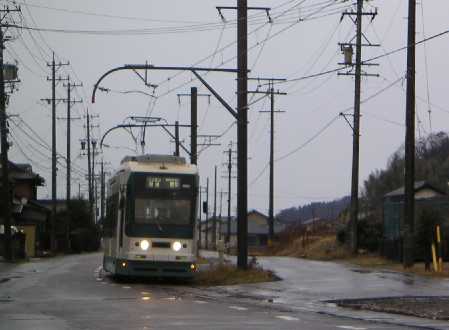 |
Nagoya Railway, famous regional rail operater in Nagoya metropolitan area, had 600v electrified streetcar lines in Gifu. These lines were named , "Minomachi Line","Tagami Line","Ibi Line","Gifu shinai Line".
Content
1. Features of tramway line
1-1. Minomachi Line
1-2. Tagami Line
1-3. Gifu Shinai Line
1-4. Ibi Line
1-5 Abandanded Lines before 2005
2. Car Roaster
3. Preservation action vs destruction policy
4. Reconstruction Movement
5.Links
1.Features of Tramway line
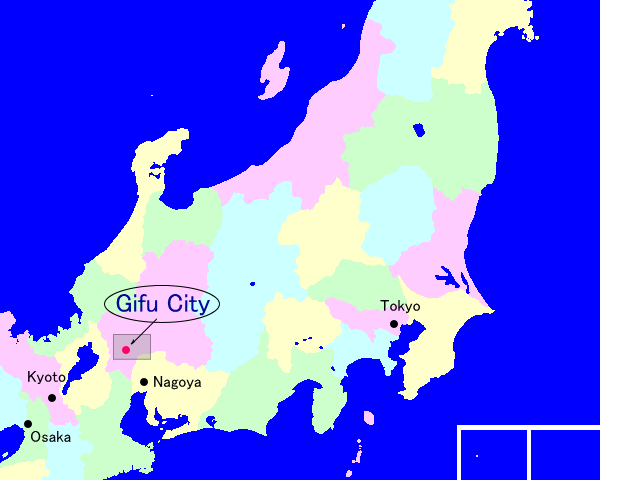 |
 |
Dotted line: Abandanded Nagoya Railroad 600v lines before 2005.
1-1 Minomachi Line
Gifu(Gifu Tetsumei Cho)-Seki 18.8km
Before 1970, Minomachi line's terminal in Gifu is Gifu Tetsumei Cho. Passengers from Nagoya Railroad main line or Kokutetsu(Japan National Railway) Tokai line had to chnge trains twice. To avoid this inconveniences, Nagoya Railroad began to construct Tagami Line for thorough operation to Shin Gifu. Shin Gifu is Nagoya Railroad main line terminal and only apart from 1 blocks Kokutetsu Gifu Station.
Speed limit of this line is only 40km per hour and Gifu-Seki train takes about 1 hour(express train slightly faster). This was a reason to discontinue this line.
<History>
Aug. 20 1930 Mino Electric Railway absorbed Nagoya Railroad
Jun. 25 1970 By using Tagami and Kagamigahara line, thorough operation to Shin Gifu was started.
Apl. 1 1999 Shin Seki-Minomachi(About 6km) abandanded.
Shin Seki-Seki(0.3km) opend for transfer Nagaragawa Railway in Seki station.
Apl. 1 2005 All route abandanded.
<Photo>
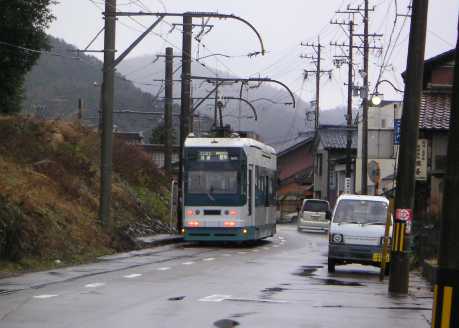 |
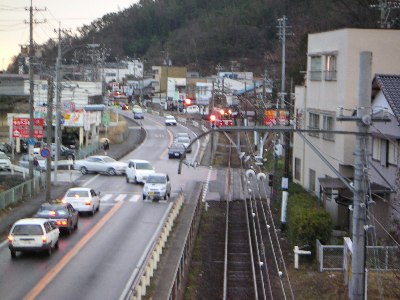 |
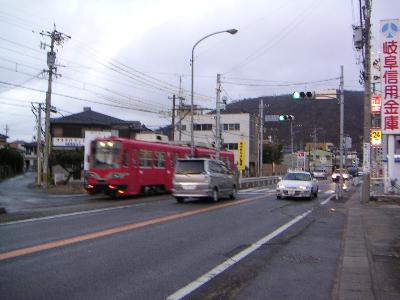 |
1-2 Tagami Line
Tagami-Keirinjyomae 1.4km
Apl. 1 2005 Abandanded.
1-3. Gifu Shinai Line
Gifu Ekimae-Chusetsu 3.7km
Because of thorough operation to Ibi line, Gifu Shinai line had express operation in midday hours.
<History>
Nov. 20 1915 Yanagase-Nagara Kitamachi opened.
1925 Tetsumeicho-Chusetsu(Chusetsu Bridge) opened.
Jul. 1 1953 Thorough operation to Ibi line started.
Jun. 1 1988 Tetsumeicho-Nagara Kitamachi abandanded because of Gifu Future Expo.
Apl. 1 2005 All route abandanded.
<Photo>
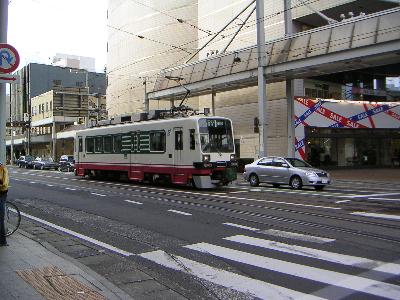 |
1-4. Ibi Line
Chusetsu-Kurono 12.8km
This line used heavy wooden or steel car like a Nagoya Railroad main line in pre war era. But for thorough operation, these car replaced new right rail vehicle until 1998.
This line also had express operation. Express train thorough Gifu Shinai line passed smaller stops. This line was hevily constructed but not suitable for express operation. Nagoya Railroad prefer to have express operation even as amaller lines. Ibi line's express might be follow this tradition.
<History>
Apl. 6 1926 Minokitakata-Kurono opend.
Dec. 20 1928 Kurono-Honibi opened.
Dec. 17 1967 Thorough operation to Gifu Ekimae via Gifu Shinai line had started.Oct. 1 2001 Kurono-Honnibi abandanded.
Apl. 1 2005 All route abandanded.
<Photo>
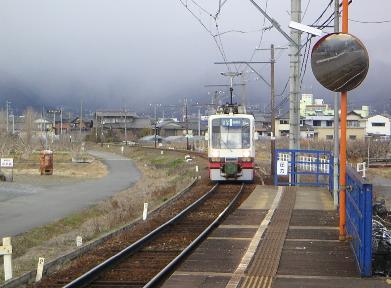 |
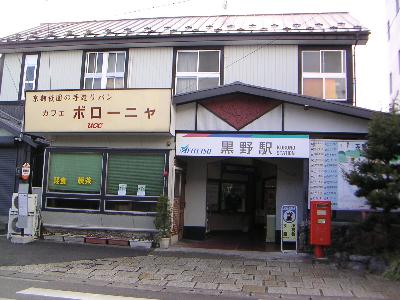 |
 |
1-5. Abandanded line before 2005
Kurono-Tanigumi 11.2km 1926-2001
Kagamishima Line
Sennjyudou(between Tetsumeicho and Chusetsu)-Nishi Kagamishima 4.4km 1924-1964
Takatomi Line
Nagarakitamachi-Takatomi 5.3km 1913-1960
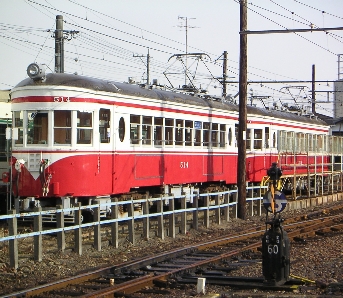 |
(1) 510 Series Built in 1926 by Nippon Sharyo. In 2005, 2 cars(513, 514) had survived. Oldest car in GIfu tramway lines. Motor and track were duplication US and British car builder. Tracks resemble Brill27-MCB-1, Motors were dupulicated from English ectric's DK31-SN. Controller were genuine Westinghouse HL-480F. <Left: 513,.514 Kurono Station> |
(2)570 Series
Built in 1950, 1953, 1954. 3 cars had survived in 2005.
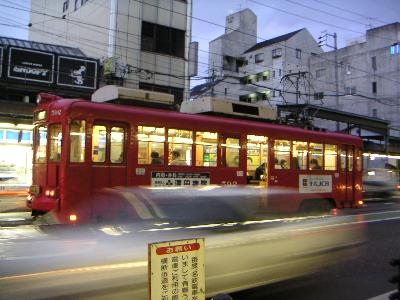 |
(3)590 Series Built in 1957 by Nippon Sharyo. In 2005, 3 cars had survived. For Minomachi line. <Left: 592 on Tetsumeicho> |
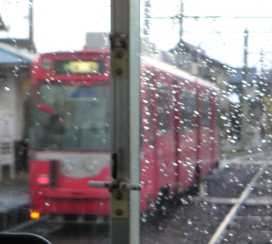 |
(4)870 Series Former Sapporo City Transportation Bureau A830 series. Built in 1965 Tokyu Sharyo. Nagoya railroad bought it in 1976. 2 train sets had survived in 2005. <Left: 870 on Shimoakutami station> |
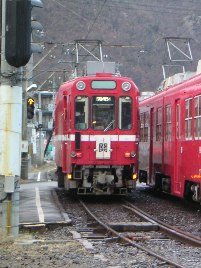 |
(5)600 Series Built in 1970 by Nippon sharyo Only 606 were survived in 2005. 600 Series were not completely new car. It used old car parts. 601 and 602 were mounted Baldwin 42-84-MCB-1 tracks. Its controller Westinghouse HL480F. <Left: 606 in Hinohashi> |
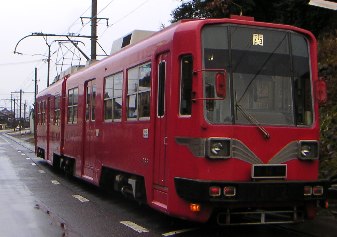 |
(6)880 Series Built in 1980 by Nippon sharyo. 5 articulated train set(10 cars) were made, and all were survived in 2005. These cars were sold to Fukui Railway. <Left: 880s in Kamiakutami Stop> |
(7)770 Series
Built in 1987-1988 by Nippon sharyo for Ibi line modernization.
5 articulated train set(10 cars) were made, and all were survived in 2005.
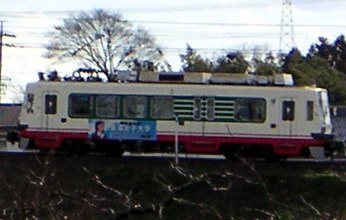 |
(8)780 Series Built in 1997-1998Nippon sharyo. For Ibi line Modenization. 7 cars were built and all survived in 2005. These cars sold to Toyohashi Railway. <Left: 780s near Mino Kitakata Station> |
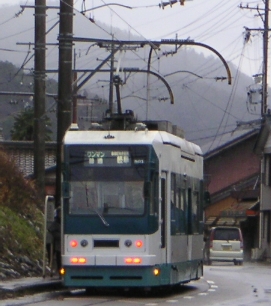 |
(9)800 Series Stepless Light Rail Vehicle for Minomachi line. Built in 2000 by Nippon sharyo 3 cars. Sold to Fukui Railway(2 cars) and Toyohashi Railway(1 car) <Left: 801 in Kamiakutami Stop> |
Low speed became serious problem, too. Thorough train from Ibi line to Gifu Ekimae took about 20 minute their 3.7km street runnning on Chusetsu-Gifu Ekimae. Most of residents became using automobile to go to sopping center, their office or JR, which they can go to Nagoya much faster, via JR station.
Patronage declined drastically on 1970-1990, but Gifu has 400,000 population. Rehabilitation or new line construction might give a chance to attract new passenger. Although Gifu tramways earned deficit, its operater -Wealthy Nagoya Railway company- invested for its modernization. Nagoya Railroad constructed Tagami Line in 1970 and purchase new LRV's. But it did not lead remarkable change. In 2004 Nagoya Railway company decided to discontinue all these lines.
Gifu municipal government discussed to buy property. But if city bought tram line, the city have to spend the money to cover operating deficit. Not like US or Europian country, subsidy for operating deficit is not common in Japan. Even public-owned subway, subsidize to operating loss is not permitted on usual condition(Subsidy of subway provide for construction in Japan). Municipal government considerd city owned tramway, but soon gave up this idea.
Shortly after the city gave up preservation, "Foregn Pressure" came on. Connex (Veolia Transport), international transport contracter in France, offerd Gifu municipal government tramway operation. It lead a controversy in Japan. But there has some distance Japanese people and Connex in dealing transportation company. Most Japanese people hoped Connex to operate Gifu tram line without subsidy, but Connex was premised on subsidy. The negotiation soon failed inconclusively.
Some citizens developed presavation movement, but it haven't became larger. Finally all lines discontinue in Apl. 1 2005.
4.Reconstruction Movement
Do you want to be a one of first Japanese LRT builder?
Further information, See http://chal.dyndns.org/~angel-fund/total.html
or E-mail to me(interurban@usrail.info).
5. Links
Nagoya Railroad official website(English)
Japan Tramway Socirty's official website(English)
and their news page"Gifu city area tramway withdrown"
Nagoya Railroad -English Wikipedia
<History of this page>
Dec 12, 2005 First edition.